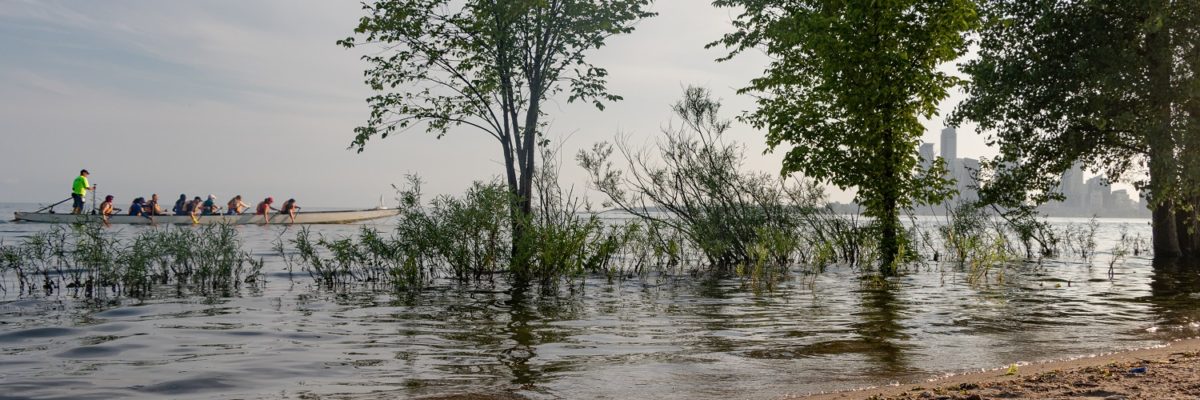Climate change isn’t fair. Countries that have contributed the least to causing climate change are often among the most vulnerable to its impacts. Across the world, for the most part, the people and communities bearing the biggest burden of this global issue are largely affected by the actions taken in other parts of the world.
We all know this. But most of us don’t often think about how that inequity also exists locally. Here at TAF, it’s something we’re trying to grapple with and improve our programs and work to reflect. Here in the GTHA, people are experiencing the impacts of climate change and its related policies – but our experiences are not all equal. People who belong to equity-seeking groups are disproportionally impacted by the environmental, economic and social burdens linked to climate change.
Solutions to climate change can offer many non-environmental benefits, but they can also create unintended harms, or burdens
Seems normal that some solutions have both positive and negative consequences, but the issue lies in how those benefits and harms are distributed across different groups. The fact is, who is impacted by climate change may largely depend on socio-economic factors, such as income, location, and race. For instance, consider that the federal government hopes to use revenues from the Trans Mountain pipeline to invest in climate action, all while creating economic and energy opportunities for the country; however, when absent of meaningful consultation and co-led solutions, this can lead to the exploitation of Indigenous land and resources, while also posing significant risks to their health and well-being.
At a more local level, let’s consider transportation in the city
Toronto has done a relatively good job at developing a transportation infrastructure that offers many low-carbon options – subway, streetcar, bus, bike, walking, and even hoverboard. But have you ever taken transit in the suburbs? Or literally anywhere that’s not near a major subway line? If you answered yes, you’ll understand that access to transit is not equally available across the city. In particular, low-income groups are the most underserviced by Toronto’s transit system.
The lower your income, the less likely you are to live along the subway line, resulting in a much longer commute, less fuel-efficient transit, and fewer transportation options. Not only is this a loss of time and productivity, but it means more emissions and more pollution, which increases public health risks. It also means less reliable service, and a greater likelihood that you’ll often be the only person waiting at a bus stop in the middle of nowhere during off-peak hours, which creates safety concerns for vulnerable members of our community.
This type of infrastructure (or lack thereof) reduces urban accessibility, creating an incentive to own a vehicle (if that option is even available). Of course, driving a vehicle has carbon impacts, and less pedestrian- and transit-friendly neighbourhoods also leads to a decline in social relationships and has lasting impacts on physical health and mental well-being.
In the last few decades, there has a been a major shift in the distribution of the city’s population along socio-economic lines. More specifically, lower-income communities have become increasingly concentrated along the outskirts of the city, towards the suburbs. In those same areas are most of Toronto’s Black, Chinese, South Asians, recent immigrants, and other visible minority populations. These are some of the groups that are far less likely to have access to a strong transportation infrastructure and far more likely to experience those harms in their physical environment, and in their health.
It’s a similar story when we look at another key source of carbon emissions: buildings
Racial minorities and people of low socio-economic status are more likely to live in substandard housing, which often means:
- Less energy-efficient homes, and consequently, large energy bills
- Less comfortable living conditions
- Adverse impacts on mental health outcomes
- More vulnerability to extreme weather and environmental risks
There is growing evidence that people who belong to equity-seeking groups are disproportionately impacted by climate change and its related policies. If you’re interested in learning more about these inequities and how we can work towards advancing equitable climate action, read our recent literature review on this topic.
At TAF we work to integrate equity into our practices
TAF’s TowerWise program takes account of people, not just the planet. The program demonstrates the value of deep energy retrofits, with a key focus of improving indoor environmental quality and resident comfort. These outcomes are important not just for the sake of improving one’s living conditions, but also to improve health outcomes and ensure that people have control over things like heating conditions in their home.
Through TowerWise, TAF is collaborating with Building Up to provide employment and training opportunities to individuals from equity-seeking groups, facilitating their participation in the growing energy efficiency sector.
TAF understands that people are affected differently by climate solutions and that there is an opportunity to integrate equity into our practices and programs. We are learning how to apply an equity lens across our areas of work to better understand how climate solutions can create both benefits and harms – and how this understanding can allow us to create more robust climate solutions.
We look forward to continuing to evolve our thoughts on this issue.

